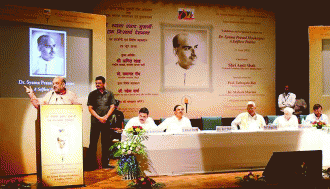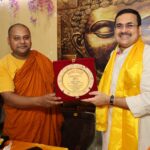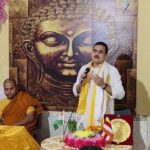NEW LIGHT ON FORGOTTEN STALWARTS
- By : Anirban Ganguly
- Category : Articles

An exhibition on the multifaceted aspects of the life and legacy of Syama Prasad Mookerjee at the Nehru Memorial Museum & Library in Delhi has raised the hackles among those who have imposed a mono-narrative on us and have been intolerant towards a diversity of views
For the first time, since his untimely death 63 years ago, Syama Prasad Mookerjee was allotted a 400 square feet area, for about a fortnight, in Nehru Memorial Museum & Library (NMML) so that an exhibition on his life and contribution to our national life could be displayed. This effort raised the hackles of sections that have, over the last four decades, always imposed a mono-narrative on us and have generally been intolerant towards diversity of views, and of reading. For some who believe that the Nehru Memorial Museum was the first Prime Minister’s personal property or that of his present descendents, such a move was sacrilegious. Such is the actual level of tolerance and acceptance of a section that has, ad nauseam, been reminding others of the need for dialogue and tolerance.
Shaped as they have been by the line and narrative which fete only some leaders and their legacy, this group was also particularly incensed that BJP president Amit Shah should have been invited to inaugurate the exhibition and deliver an address in which he freely and yet, with great insight, discussed the principal personalities — that is Mookerjee and Nehru, the main political issues of that age and especially the crucial contributions and interventions of Mookerjee.
Shah had argued in his talk that a serious study of the period that led to India’s independence and the phase immediately after that cannot be studied without making an assessment of Mookerjee. Shah had also expressed his appreciation of the efforts made by the NMML and its staff to put up this exhibition. The stereotype that is habitually applied to the so-called “Right-wingers” by the power elites of the national capital and by their hangers on in the academia and media did not fit Shah — how could he deliver a well-woven and well-argued speech on political history
they questioned, that preserve was best left to themselves and to the card holder and certified historians of the Marxian mould.
Instead of allowing and appreciating a free and open discourse and debate on these aspects of our history, all that this section did, was to take pot shots at Shah. The likes of Jaipal Reddy and Kamal Morarka, themselves consigned to the pantheon of Congress history, suddenly resurrected themselves or were resurrected and attempted to generate an ill informed debate on Mookerjee’s life and contributions.
Out from the political cold storage after a long spell, they were obviously out of depth and instead of appearing as calibrated assessors of the history of post-independence India, they simply exposed their own ignorance and convoluted thinking.
After all, habituated to supping for so long an ideological potage that is devoid of logic or pint of rationality, these political leaders have given up their faith in the necessity and usefulness of wide thinking, of alternate view points and in the need for recognising the contributions of a large number of leaders who too had India’s interest and well-being at heart. Since their political fortunes have always depended on singing paeans to one political dynasty, the habit of intellectual discovery and quest have long since overtaken them. The last historian worth his salt in the original Congress was Bhogaraju Pattabhi Sitaramayya and even he would lament how ill-appreciated his work on the Congress history was.
Others, less informed who believe that the NMML is meant to only promote and support research on Nehru’s life, overlook or are ignorant of the fact that its mandate is to conduct research on and preserve papers and documents of our freedom fighters, revolutionaries, our Constitution framers and all those leaders who have shaped India’s polity pre and post independence. For them, the move to commemorate the contributions of Mookerjee was an act that defiled the original intent of the institution and, therefore, worthy of being belittled or condemned.
They do not know or have little recollection of the fact that the NMML is one of the best and largest repository of private papers, of papers and documents connected to our struggle for freedom, of documents that narrate the revolutionary dimension of our freedom struggle, of political documents, of documents that depict the evolution of politics in modern India, of oral histories and a host of other genres. It is worth recalling the herculean effort Haridev Sharma made in collecting these wide genres of papers from across the country and the world. His indefatigable exploits in collecting these papers and in turning NMML into a rich storehouse of documents that narrate all political views is indeed by itself a saga worth recording.
Papers connected to Mookerjee himself run into 70,000 pages. The NMML has the Vinayak Damodar Savarkar papers, the Hindu Mahasabha papers, Asutosh Lahiri papers, and much more. It was physically and conceptually impossible to use all details present in these thousands of pages for the exhibition — which was of a limited framework with 250 words per exhibit panel consisting of 18 panels in all.
The exhibition was meant to give an idea of Mookerjee’s multi-dimensional personality and aimed at encouraging the actual researcher, the political worker, the scholar and academic to undertake a serious study of his life and times and of his thoughts as well.
The fact that the exhibition also liberally used and displayed primary sources, letters and correspondences — letters exchanged between Mookerjee and Mahatma Gandhi, between Mookerjee, Sardar Patel and Nehru, especially the period of his resignation from the Union Cabinet and his own diary, letters he wrote to other personalities — made it stand apart from some other such exercises in the past. The idea was, as one of the senior curators working on it noted, to encourage the observer and readers to delve into the rich collection of primary documents that the library stored and thus give rise to a spirit of inquiry and research.

















